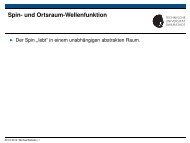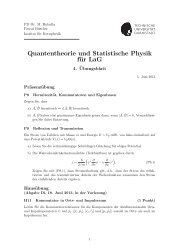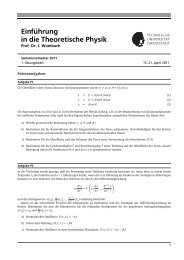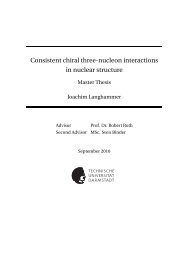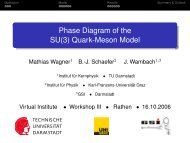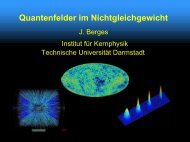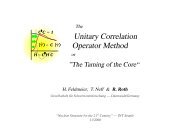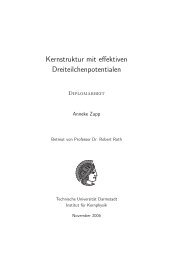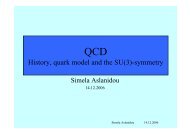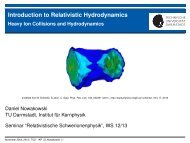Br ¨uckner-Hartree-Fock with Realistic Nucleon-Nucleon Potentials
Br ¨uckner-Hartree-Fock with Realistic Nucleon-Nucleon Potentials
Br ¨uckner-Hartree-Fock with Realistic Nucleon-Nucleon Potentials
You also want an ePaper? Increase the reach of your titles
YUMPU automatically turns print PDFs into web optimized ePapers that Google loves.
<strong>Br</strong>ückner-<strong>Hartree</strong>-<strong>Fock</strong> <strong>with</strong><br />
<strong>Realistic</strong> <strong>Nucleon</strong>-<strong>Nucleon</strong> <strong>Potentials</strong><br />
Patrick Hedfeld<br />
Institut für Kernphysik, TU Darmstadt
Overview<br />
■ <strong>Realistic</strong> <strong>Potentials</strong> & Effective Interactions<br />
■ Unitary Correlation Operator Method (UCOM)<br />
■ <strong>Hartree</strong>-<strong>Fock</strong> + Perturbation Theory<br />
■ <strong>Br</strong>ückner-<strong>Hartree</strong>-<strong>Fock</strong> (BHF)<br />
■ Summary & Outlook
<strong>Realistic</strong> <strong>Potentials</strong> & Effective Interactions<br />
<strong>Realistic</strong> <strong>Potentials</strong><br />
■ QCD motivated: based on meson exchange picture or chiral effective field<br />
theory<br />
■ fitted to properties of the deuteron and phase shifts<br />
■ need a short-range repulsion and tensor force<br />
Examples: AV18, CD Bonn, Chiral N 3 LO . . .<br />
Effective Interactions<br />
■ simple model spaces cannot describe short-range correlations<br />
■ adapt realistic potentials to<br />
model spaces while conserving phase shifts of the realistic potential
Unitary Correlation Operator Method<br />
Correlation Operator<br />
introduce short-range correlations by<br />
means of a unitary transformation <strong>with</strong> respect<br />
to the relative coordinates of all pairs<br />
<br />
C = exp[−i G] = exp − i <br />
gij Correlated States<br />
<br />
ψ = C ψ <br />
i
φ <br />
.<br />
<br />
φ r Cr<br />
.<br />
<br />
φ r CΩCr<br />
.<br />
Correlated States: The Deuteron<br />
0.15<br />
0.1<br />
0.05<br />
0<br />
0.15<br />
0.1<br />
0.05<br />
0<br />
0.15<br />
0.1<br />
0.05<br />
0<br />
L = 0<br />
1 2 3 4 5<br />
r [fm]<br />
1 2 3 4 5<br />
L = 0 r [fm]<br />
L = 2<br />
1 2 3 4 5<br />
r [fm]<br />
central<br />
correlations<br />
tensor<br />
correlations<br />
[fm]<br />
.<br />
0.2<br />
0.15<br />
0.1<br />
0.05<br />
0<br />
0.08<br />
0.06<br />
0.04<br />
0.02<br />
s(r)<br />
1 2 3 4<br />
r [fm]<br />
ϑ(r)<br />
. 0<br />
1<br />
only short-range tensor<br />
correlations treated by CΩ<br />
2 3<br />
r [fm]<br />
4
Binding Energies & Radii<br />
E/A [MeV]<br />
.<br />
Rch [fm]<br />
.<br />
0<br />
-2<br />
-4<br />
-6<br />
-8<br />
5<br />
4<br />
3<br />
2<br />
1<br />
4 He 16O<br />
24O 40<br />
34Si<br />
Ca48Ca48<br />
Ni56Ni68<br />
Ni78Ni88<br />
Sr90Zr100<br />
Sn114Sn<br />
132Sn146Gd 208Pb experiment ● HF
.<br />
.<br />
Binding Energies & Radii<br />
E/A [MeV]<br />
Rch [fm]<br />
0<br />
-2<br />
-4<br />
-6<br />
-8<br />
5<br />
4<br />
3<br />
2<br />
1<br />
4 He 16O<br />
24O 40<br />
34Si<br />
Ca48Ca48<br />
Ni56Ni68<br />
Ni78Ni88<br />
Sr90Zr100<br />
Sn114Sn<br />
132Sn146Gd 208Pb experiment ● HF HF+PT2 RPA<br />
long-range<br />
correlations are<br />
perturbative<br />
(PT, BHF, RPA,...)
Bethe-Goldstone-Equation<br />
Equation<br />
G ω = W + W 1 Q<br />
G<br />
2 ω − H0<br />
Implementation<br />
Inversion<br />
Iteration<br />
G ω = W + W 1<br />
G ω = [ − 1<br />
2<br />
Q<br />
2 ω − H0<br />
Explanation<br />
W = T − Tcm + VUCOM + VC<br />
ω : starting energy<br />
Q : Pauli operator<br />
H0 : single particle Hamiltonian<br />
Q<br />
W]<br />
ω − H0<br />
−1 W<br />
W + W 1<br />
4<br />
Q<br />
ω − H0<br />
W Q<br />
W + . . .<br />
ω − H0
Correlations I<br />
Vab[MeV]<br />
.<br />
10<br />
5<br />
0<br />
-5<br />
ǫFermi = 1ω<br />
-10<br />
-10 -5 0<br />
Gab[MeV]<br />
5 10<br />
ǫmax=6ω<br />
J = 1<br />
T = 0
Correlations II<br />
V ab[MeV]<br />
ǫmax=6ω<br />
.<br />
V ab[MeV]<br />
.<br />
10<br />
5<br />
0<br />
-5<br />
ǫ Fermi = 6ω<br />
-10<br />
-10 -5 0<br />
Gab[MeV] 5 10<br />
10<br />
5<br />
0<br />
-5<br />
ǫ Fermi = 3ω<br />
-10<br />
-10 -5 0<br />
Gab[MeV] 5 10<br />
V ab[MeV]<br />
.<br />
V ab[MeV]<br />
.<br />
10<br />
5<br />
0<br />
-5<br />
ǫ Fermi = 5ω<br />
-10<br />
-10 -5 0<br />
Gab[MeV] 5 10<br />
10<br />
5<br />
0<br />
-5<br />
ǫ Fermi = 2ω<br />
-10<br />
-10 -5 0<br />
Gab[MeV] 5 10<br />
V ab[MeV]<br />
.<br />
V ab[MeV]<br />
.<br />
10<br />
5<br />
0<br />
-5<br />
ǫ Fermi = 4ω<br />
-10<br />
-10 -5 0<br />
Gab[MeV] 5 10<br />
10<br />
5<br />
0<br />
-5<br />
ǫ Fermi = 1ω<br />
-10<br />
-10 -5 0<br />
Gab[MeV] 5 10
Fully Self-Consistent BHF<br />
until EB<br />
converged<br />
single particle<br />
energies<br />
and states<br />
<strong>Hartree</strong>-<strong>Fock</strong><br />
Bethe-<br />
Goldstone-<br />
Equation<br />
(ω)<br />
VUCOM<br />
as first input<br />
matrix elements<br />
of the effective<br />
interaction
Results<br />
E/A[MeV]<br />
.<br />
-4<br />
-5<br />
-6<br />
-7<br />
-8<br />
-9<br />
EExp<br />
40 Ca<br />
-10<br />
2 4 6 8 10<br />
ǫmax ω<br />
EExp<br />
90 Zr<br />
4 6 8 10<br />
ǫmax ω<br />
EExp<br />
208 Pb<br />
4 6 8 10<br />
ǫmax ω
ǫmax=10ω<br />
Binding Energy & Radii<br />
preliminary<br />
results<br />
.<br />
.<br />
E/A[MeV]<br />
Rch[fm]<br />
-4<br />
-6<br />
-8<br />
5<br />
4<br />
3<br />
2<br />
4He16O 24O34Si 40Ca48Ca 56Ni 88Sr90Zr 100Sn114Sn 132Sn146Gd 208Pb 68Ni<br />
experiment ● HF BHF HF+PT2
Summary & Outlook<br />
■ UCOM describes short-range correlations and ’tames’ the<br />
interaction; can be used in HF (BHF, RPA . . . )<br />
■ fully self-consistent BHF based on the realistic two body interaction<br />
VUCOM<br />
■ results for the energy <strong>with</strong> BHF are in good agreement <strong>with</strong><br />
experiment and second-order perturbation theory but radii<br />
are not much improved<br />
■ Outlook: other ’strategies’ for the starting energy, Padè approximants<br />
in the iterative scheme
Epilogue...<br />
My Collaborators<br />
■ R. Roth, P. Papakonstantinou, H.Hergert, A. Zapp<br />
Institut für Kernphysik, TU Darmstadt<br />
References<br />
■ R. Roth, P. Papakonstantinou, N.Paar, and H. Hergert, Phys. Rev. C73, 044312 (2006)<br />
■ R. Roth, H.Hergert, P. Papakonstantinou, T.Neff and H. Feldmeier, Phys. Rev. C72, 034002 (2005)<br />
■ C. Barbieri, N.Paar, R. Roth and P. Papakonstantinou, arXiv: nucl-th/0608011 (2006)<br />
■ http://crunch.ikp.physik.tu-darmstadt.de/tnp/



